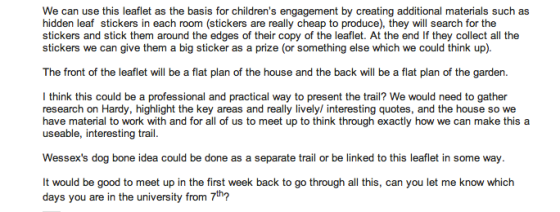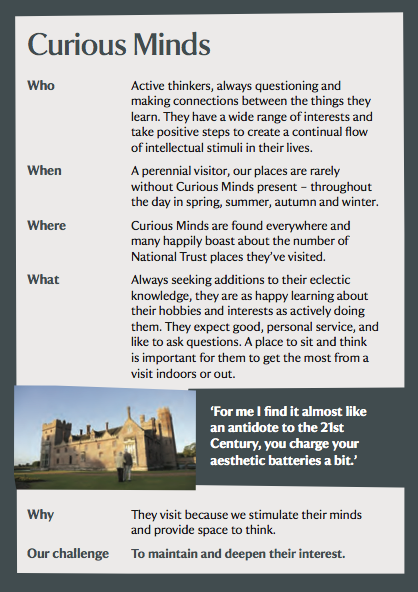Today the team got on a mini bus and made the trip down to Dorchester to visit Max Gate. It was nice to re-visit the property and see the staff members again.
We were given the opportunity to look around the house and also meet with Jennifer, the house manager. She presented us with a full brief and criteria that we must follow throughout the project. This was really helpful and cleared up a few confusions the team had, in particular the location of the trails. Jennifer asked that we restrict the trails to the house grounds; this would be safer and not encourage people wander into the Dorset landscape, it made sense! See below the brief which we were given.
Hardy country project
National trust and bath Spa University, 2012-2013
Project Brief
Project summary
This project has been designed to provide BSU students with direct involvement in designing and producing a range of materials and / or activities for the National Trust at Max Gate, Dorchester, which will help enhance the visitor experience as the house is refurbished and redevelopment as part of the Trust’s portfolio.
These materials will consist of:
- A trail or series of trails around the house and garden at Max Gate, designed for the Trust’s target audiences (Curious Minds, Explorer Families, and Out and About);
- A family activity linked to these trails, to take place during spring half-term, 2013;
- An event or activity aimed at attracting young people (18-24 year olds – a ‘hard to reach’ group’) to the property and encouraging them to engage them more broadly in the work of the Trust.
Key criteria
- You can design and produce a single trail exploring the house and garden, or a series of themed trails, available in print and / or digitally. The trails must be self-directed; and should be designed to be used with minimal intervention by Trust staff and volunteers on a day-to-day basis (e.g. the Trust will reprint them, but should not have to update or revise the trails in the short to medium-term);
- The trail may take a variety of forms (e.g. letters or snippets of information to be discovered; objects to find), but the connection with Hardy and the house must be clear throughout;
- The trails must follow NT branding in the use of the logo and the Trust’s font (these will be supplied);
- Planned events are normally expected to cover their costs, so it will be necessary to think carefully about any materials used and whether a charge will be needed;
- Events can take place during the day when the house is open or in the evening;
- A series of Hardy lectures is already planned for the first two weeks of June 2013, so it is recommended that lectures are not included as part of this project – poetry readings, storytelling or performance might be more attractive options;
- Simple marketing materials will be prepared as part of the project: posters to advertise any events locally; press releases for the local press; online entries;
- You must prepare a single page briefing sheet for NT volunteers which explains what you are doing and which ‘sells’ the project to them;
- Printing and production costs will be met by the Trust, but must be agreed in advance with the Visitor Services Manager;
- As well as agreeing the budget with the Trust for producing any materials or activities, you must agree visits to the house with BSU in advance. There is a budget to cover travel expenses but this is fixed, so careful planning and delegation will be essential to ensure that you can remain within it.
Potential partners
The Trust already has good contacts with the following people and organisations:
- The New Hardy Players
- Tim Laycock (NHP director, performer)
- The Hardy Society
- St Oswald’s Middle School
All of the above may be helpful in developing both the trails and the events. Let the Trust know before you contact them for the first time, and make sure that you keep them ‘in the loop’ as these conversations develop.
Deadlines
These deadlines provide the framework in which you will need to prepare a detailed project plan.
11 January 2013 Initial response to the brief – outline proposals presented to the Trust (at BSU)
8 February 2013 Final proposals presented to the Trust and a representative of the Hardy Society (at BSU)
5 April 2013 Final copy for marketing materials to Trust for formal sign off
26 April 2013 Final copy for trails to Trust for formal sign off
10 May 2013 Final PDF to printers
24 May 2013 Print delivery to Max Gate
26 May-2 June 2013 Half-term week (NB the house is open all week, except Tuesday)
Whilst in Dorchester we also took a quick visit to the Dorset County Museum. Thomas Hardy is quite a celebrity in Dorchester, so of course part of the Museum was dedicated to him! On his death, Hardy’s wife Florence donated the furniture from his study to the museum, it was interesting to view this.
All in all it was a very productive day and I left with a better understanding of what the Trust were expecting us to produce. I was still struggling to connect with the team, but knew I must persevere.









